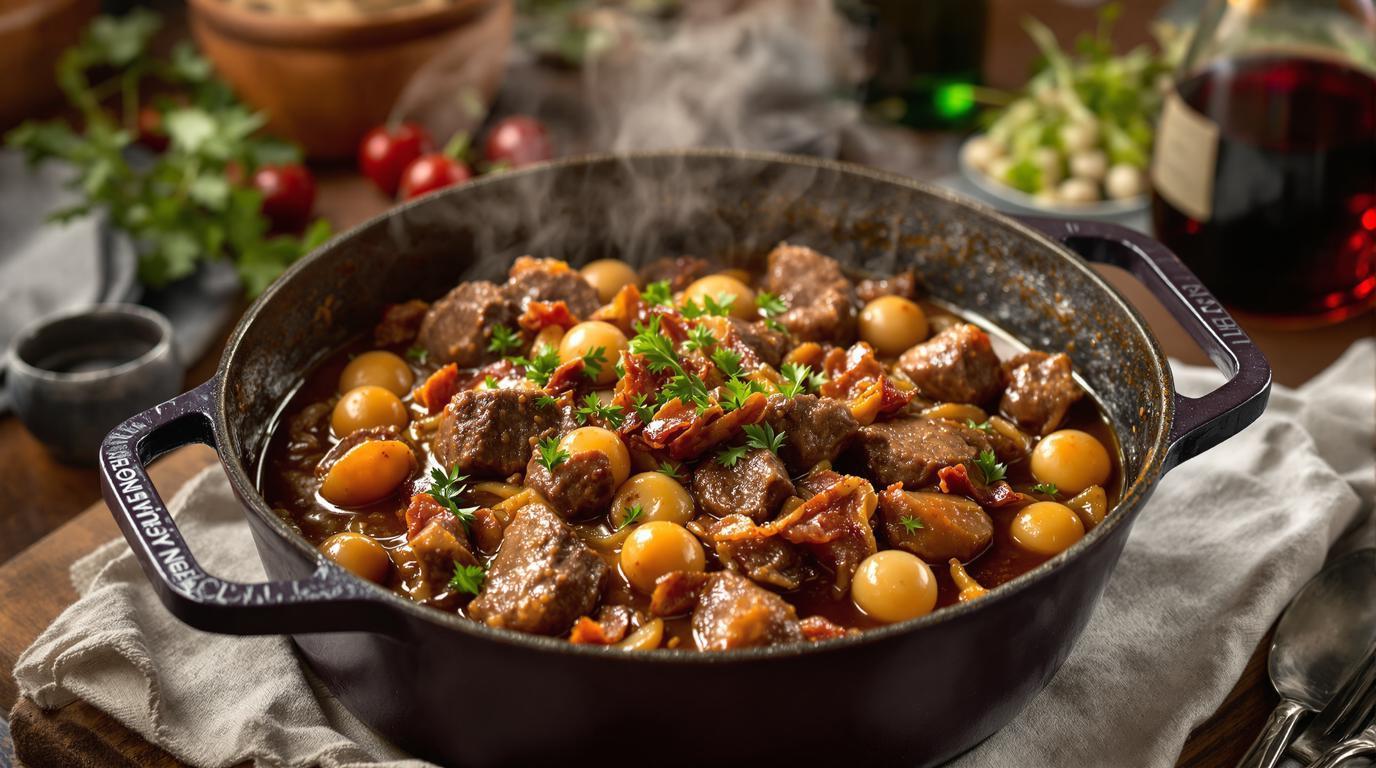It was midnight in Lyon when I first tasted authentic Bœuf Bourguignon that made me reconsider everything I thought I knew about beef stew. The meat yielded to my fork with barely any pressure, dissolving into a sauce so rich and complex that I immediately understood why this humble dish had earned legendary status. What surprised me most wasn’t the ingredients—which are remarkably simple—but the transformative power of proper technique and patience. This isn’t fast food; this is slow magic happening in your Dutch oven.
The Story Behind the Braise
Bœuf Bourguignon originated as peasant cuisine in eastern France, where resourceful cooks transformed tough cuts of beef into luxurious meals using local wine. While working in a small bistro outside Dijon, I learned that the real secret isn’t in rare ingredients but in respecting time-honored techniques. The dish exemplifies what I love most about French cooking—transforming humble components into something extraordinary through technique rather than extravagance.
What makes a truly authentic French casserole special is the gradual building of flavors. Like its cousin Burgundian braised short ribs, this dish embraces the slow-cooking philosophy that defines regional French cuisine.
Ingredients Spotlight
For the base (serves 6):
• 3 pounds (1.4kg) beef chuck, cut into 2-inch cubes
• 8 ounces (225g) bacon lardons or thick-cut bacon cut into ¼-inch strips
• 2 medium yellow onions, thinly sliced
• 3 medium carrots, cut into 1-inch pieces
• 1 tablespoon tomato paste (optional but adds depth)
• 2 tablespoons all-purpose flour
• 1 bottle (750ml) dry red wine (Burgundy or Pinot Noir)
• 2 cups (475ml) beef stock
• 1 bouquet garni (4 sprigs thyme, 2 bay leaves, 6 parsley stems tied together)
• 3 cloves garlic, smashed
• 1 tablespoon unsalted butter
For the garnish:
• 16 pearl onions, peeled
• 8 ounces (225g) cremini mushrooms, quartered
• 2 tablespoons fresh parsley, chopped
Step-by-Step Guide
1. Prepare the beef: Pat the meat thoroughly dry with paper towels and season generously with salt and pepper. This critical step ensures proper browning—not steaming—of the meat.
2. Render the bacon: In a large Dutch oven over medium heat, cook the bacon until crisp and the fat has rendered, about 8 minutes. Remove with a slotted spoon, leaving the fat in the pot.
3. Brown the beef: Working in batches (never crowd the pan!), sear the beef in the bacon fat until deeply browned on all sides, about 3-4 minutes per side. Transfer to a plate.
4. Build the flavor base: Add sliced onions and carrots to the pot. Cook until softened, about 8 minutes. Add tomato paste if using and cook for 1 minute until darkened.
5. Create the liaison: Sprinkle flour over vegetables and cook, stirring constantly, for 2 minutes to remove raw flour taste.
6. Deglaze: Add one cup of wine, scraping up all browned bits from the bottom of the pot—these contain concentrated flavor compounds essential to the final sauce.
7. Combine and braise: Return beef and bacon to the pot. Add remaining wine, stock, bouquet garni, and garlic. Bring to a simmer, then cover and transfer to a 325°F (165°C) oven for 2½-3 hours, until beef is fork-tender.
8. Prepare garnish: Thirty minutes before serving, sauté pearl onions in butter until caramelized, about 8 minutes. Add mushrooms and cook until golden, about 5 minutes more. Fold into the stew.
9. Finish: Remove bouquet garni. Taste sauce and adjust seasoning. If sauce needs thickening, simmer uncovered for 10-15 minutes on stovetop.
Chef’s Note: The difference between good and extraordinary Bœuf Bourguignon lies in the browning step. Take your time here—properly caramelized meat creates depth that can’t be rushed or added later. I often spread this process over two days, braising one evening and completing the dish the next day, which allows flavors to mature spectacularly.
Expert Techniques
The key to transcendent Bourguignon lies in understanding the science of braising. When collagen in tough cuts melts into gelatin at temperatures around 160-170°F (71-77°C), it creates that luxurious mouthfeel. This is why we maintain a gentle simmer rather than a boil, which would toughen the meat.
For wine selection, choose something you’d happily drink—the flavor concentrates during cooking. A medium-bodied Pinot Noir offers balanced acidity without overwhelming tannins. This philosophy applies equally to other wine-based dishes like Provençal lamb preparations.
Presentation & Pairing Ideas
Serve Bœuf Bourguignon in shallow bowls rather than plates to showcase the sauce. Traditional accompaniments include buttered egg noodles, creamy mashed potatoes, or crusty bread, but I’ve found it pairs beautifully with roasted fingerling potatoes tossed with herbs.
For wine pairing, echo the cooking wine with a Burgundian Pinot Noir or explore contrast with a Rhône Syrah blend. If serving as part of a larger menu, consider starting with a simple Mediterranean-inspired salad and finishing with a light fruit sorbet to balance the richness.
Remember that Bœuf Bourguignon improves with time—make it a day ahead if possible. The flavors meld and deepen, and you’ll find yourself with a dish that truly captures the soul of French country cooking in your own kitchen. Let the transformation happen, and you’ll discover why this humble stew has captivated chefs and home cooks for generations.
